- Skip to primary navigation
- Skip to header navigation
- Skip to footer navigation
- Skip to content
- Skip to primary sidebar
- Skip to footer
5 Minutes for Mom

Main navigation
Tie dye milk – easy science experiment for kids.
February 24, 2014 by Janice
This post may contain affiliate links. Read my disclosure policy here .

A couple weeks ago, my six year old daughter, Olivia, had to perform a science experiment for her grade one class.
After hours of researching online, Olivia chose to do this colorful milk swirl experiment . We added our own twist to the experiment, keeping the fun going by blowing gently on the milk to “tie dye” the milk.

Olivia had a great time with this colorful milk experiment, so I think we will be making more science experiments for kids.
If you and your children want to have some colorful milk swirling fun, or if they are looking for science experiments for school, here is how you tie die milk.
Ingredients
- Full Fat Milk – (the experiment requires fat in the milk)
- Food Coloring
- Dishwashing Liquid
- Plate or Bowl
Instructions
- Cover bottom of bowl with milk
- Place a few drops of various colors of food coloring into milk
- Add one drop of dishwashing liquid into the middle of the mix
- Watch colors swirl around
- When the colors stop moving, get them moving again by gently blowing into mixture
Why it works
The food coloring is less dense than the milk and so the food colouring sits on top of the milk. The dish-soap breaks up the fat in the milk. When the fat moves, the food coloring goes for a ride on top of the milk!
What are your kids favorite science experiments? Any ideas for what Olivia should conquer next?
Written and photographed by Janice, co-founder of 5 Minutes for Mom and owner of Janice Croze Photography .
About Janice
Janice is co-founder of 5 Minutes For Mom . She's been working online since 2003 and is thankful her days are full of social media, writing and photography.
Reader Interactions
Leave a comment cancel reply.
This site uses Akismet to reduce spam. Learn how your comment data is processed .
April 28, 2015 at 6:11 am
WOW! I never heard of this experiment. Fun experiment!
Sarah at Journeys of The Zoo says
February 17, 2015 at 12:01 am
I hope I never have to come up with a Science experiment for my kids but if I do, I know which one they’ll be sharing. Thanks for the idea.
Besos, Sarah Journeys of The Zoo
Jennifer Sikora says
February 25, 2014 at 11:18 pm
We did this when the kids were little and we first started homeschooling. Looks like AJ might be blowing some bubbles later since he decided to drink the milk! ha
Janice says
February 27, 2014 at 8:32 pm
Oh AJ has eaten much worse than dish soap that crazy dog! LOL
February 25, 2014 at 12:53 am
Oh my word—she is too precious!! Totally doing this with my boy!
Thanks Sarah! I am biased of course, but I think she is beyond precious too! Have fun with this activity with your son. Let me know how it goes. 🙂
February 24, 2014 at 4:51 pm
What fun and so easy. Thanks for sharing.
February 27, 2014 at 8:33 pm
Thanks Storm! So glad it was helpful. 🙂

Healthy Chicken and Broccoli Casserole Recipe

Keto Cheesecake Bites with Caramel Pecan Sauce

The 5 Keys to Crispy Kale Chips

Buddy the Elf Hat Pattern – How to Make an Elf Hat out of Felt

20 Free Summer Printables For Kids

20 Father’s Day Gifts Kids Can Make

Holiday Gift Guides and Christmas Giveaway 2024

Valentine’s Day Gifts For Women

REDEEMING LOVE Set to Strike Gold on the Big Screen #RedeemingLoveMovie
Easy Milk Experiment • Learn About Molecules With Tie-Dye Milk
Osc at home, apr 06, 2021.
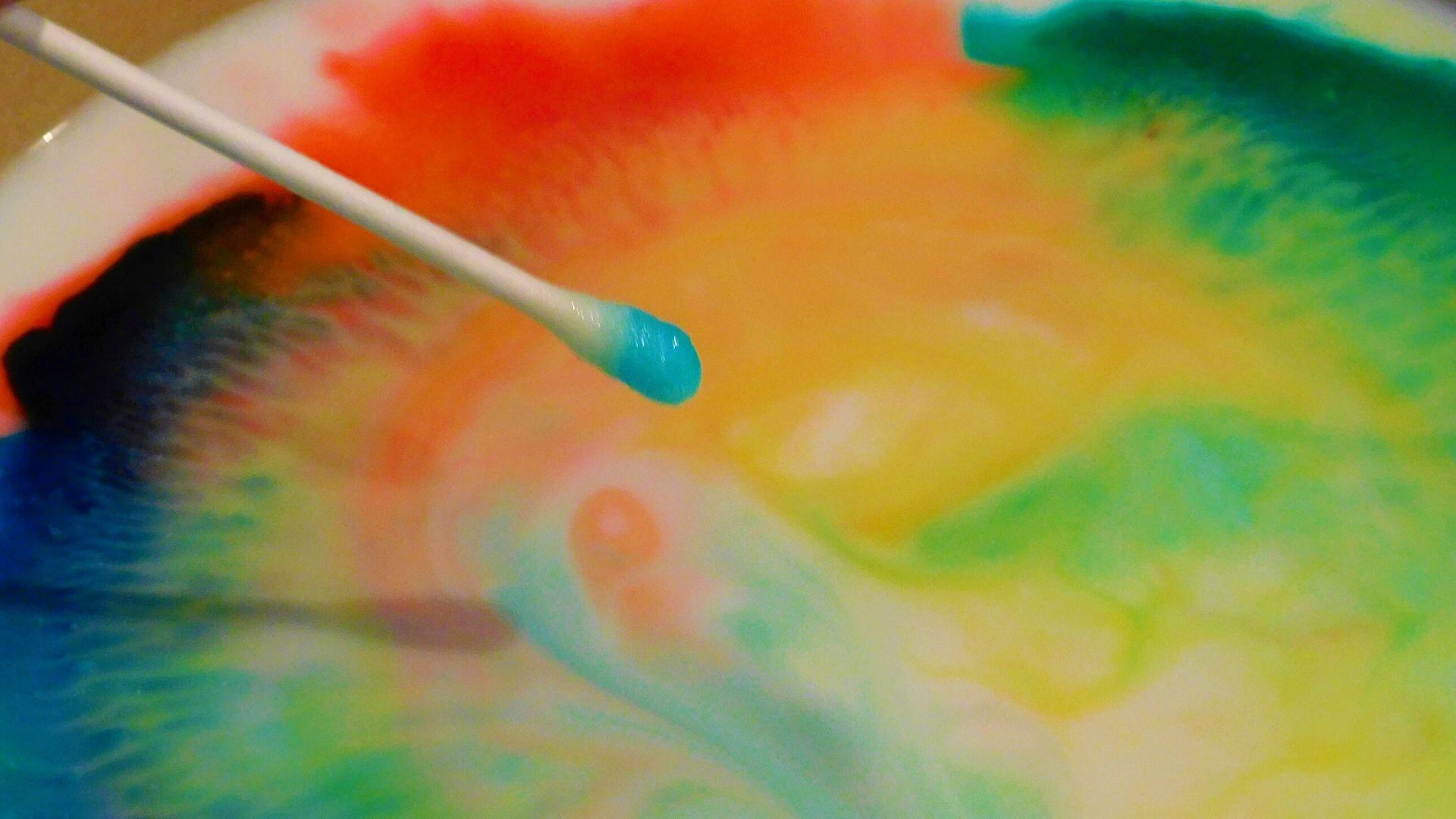
We'd like to thank our partner, Florida Prepaid, for sponsoring this colorful activity! Today’s young scientists are tomorrow’s college graduates. Saving early for college sends your child a powerful message that you believe in their future — and want them to avoid debt later. Learn more about Florida Prepaid’s College Savings Plan at myfloridaprepaid.com .
Learn about molecules and more with this easy tie-dye milk experiment
Make a rainbow of colors swirl around with materials you can find in your kitchen and a dash of science!
Atoms and molecules are the particles that make up everything. What element or elements they are, how they’re arranged, how they move, and how they interact with each other determines how a substance looks, acts, and reacts. However, atoms and molecules are very, very small. You could line up 70 million helium atoms in a row across a pencil eraser!
This makes them way too small to see with our own eyes or even with many microscopes. But we can observe molecules in motion with this tie-dye milk experiment.
Ready to make your own? Watch along or follow the written steps below!
Materials you will need:.
- Milk or cream
- Food coloring
- Cotton swabs or toothpicks
- A dish or plate with a rim that can hold liquid.
Directions:
Step 1: First, add some milk or cream to your dish. You want to make sure the milk completely covers the bottom of the dish, but you don’t need to completely fill it.
Step 2: Next, add 4 drops of food coloring to the center of the dish, being careful not to let them mix. Don’t stir the milk and food coloring! You want them to stay separate for now.
Step 3: Pick up your cotton swab or toothpick. Carefully cover one end of it with dish soap.
Step 4: When you’re ready, touch the center of the milk with the soapy end of your swab and watch the colors move!
The Science of Tie-Dye Milk
- Milk is a mixture. It’s mostly water, but it also has proteins, fats, and other molecules mixed in.
- Because milk is mostly made up of water, it acts a lot like water and has many of the same properties.
- One of these properties is called surface tension. Surface tension is how resistant a liquid is to external force, or how strong the surface of the liquid is. It’s a bit like the surface of water having a sort of “skin.” This is how some insects can walk on water.
- Soap is what we call a surfactant. It lowers the surface tension of a liquid.
- When we dip the soap in the milk, it lowers its surface tension and causes not just the water molecules, but fat and protein molecules, to move as they quickly rearrange themselves.
- By adding food coloring, we can see the movement caused by lowering the surface tension.
Expand on This Activity:
- What new colors do you see?
- How are the colors moving?
- Why do you think this happened?
- Press down on the bottom of the dish with the soap-covered cotton swab for three seconds, then lift up. How is the movement of the colors different than when you quickly touch the cotton swab to the milk’s surface?
- Touch the cotton swab to areas where the colors have collected to watch the colors continue to move.
- Try the experiment with more or fewer colors of food coloring. How is the tie-dye different?
Learn More: Chemistry
- Many atoms and molecules have positive (+) or negative (-) charges. An atom or molecule with no charge is called neutral. Positive and negatively charged atoms attract, just like the north and south poles of a magnet.
- Molecules can be polar or nonpolar. Polar molecules have one side that is much more positive or negative than the other. Nonpolar molecules don’t have a difference in charge. Polar molecule likes to mix with other polar molecules, and nonpolar molecules like mix with other nonpolar molecules. Polar and nonpolar molecules don’t mix. This is what keeps oil and water separate; oil is made of nonpolar molecules and water is made of polar molecules!
- Water molecules have a positive side and negative side. This makes water a polar molecule. Because of this, water molecules can stick to each other. Molecules in liquid sticking to each other is known as cohesion. The cohesion between the water molecules at the surface is what creates surface tension.
- Soap molecules have a negative side and neutral side, so it has both a polar and nonpolar end. The negative side of the soap molecule is attracted to the positive side of the water molecule, weakening the attraction between the water molecules and lowering the surface tension.
- But that’s not all. The neutral sides of the soap molecules also interact with the nonpolar fat molecules, separating them out of the milk. This is how soap is able to clean up greasy messes!
OSC At Home Emails
Get a round up of our latest activities and ideas delivered straight to your inbox so you don't miss a thing!
Find out when we release new resources by following us on social media!
Follow us on social media for even more science fun including fun facts, games, behind-the-scenes photos, and more!

Support OSC At Home
In these ever-changing times, it is our pleasure to adapt quality Orlando Science Center experiences to engage with everyone while they are safe at home. Please consider supporting our operating fund to ensure we can continue developing resources today and well into the future. Thank you for your generosity and support!
- Book Lists by Age
- Book Lists by Category
- Reading Resources
- Language & Speech
- Raise a Reader Blog
- Back to School
- Success Guides by Grade
- Homework Help
- Social & Emotional Learning
- Activities for Kids
DIY Science Experiment: Tie-Dye Your Milk
Explore the scientific concept of surface tension with milk, food coloring and dish soap..
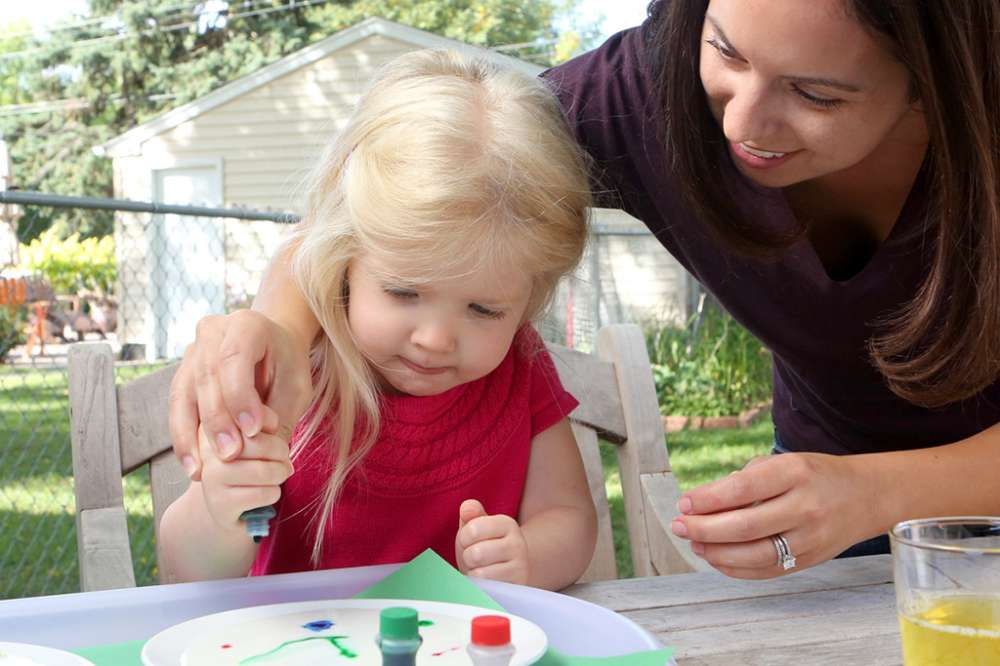
Food coloring isn’t just for frosting anymore! Your child will be amazed by this brilliant experiment that explores the forces of surface tension — the scientific name for the way the "skin" of a liquid holds together. Since this project uses food coloring, it’s fun to make a "lab coat" from an old button-down shirt to prevent staining. Write your child’s name on the pocket with permanent marker and let them decorate it!
You'll Need:
- A small, shallow dish or plate
- Milk (2% or whole milk are best, but skim milk works too)
- Cotton swabs like Q-tips
- Food coloring
How to Make Tie-Dye Milk
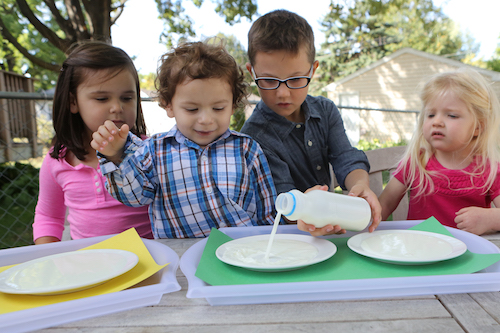
Art lovers can draw a picture of how the milk looks before and after touching it with the Q-tip, or take pictures of the beautiful patterns. They can even put a paper towel on the milk to lift the color.
The Science Behind the Fun
Imagine that surface of liquids is a stretched elastic skin, like the rubber on a balloon full of air.
When the surface tension, or skin of the milk in this experiment is broken by the dish soap, the food coloring and milk are free to swirl around.
You can find more experiments like this one at kitchenpantryscientist.com , and in my books Kitchen Science Lab for Kids (Quarry Books) and Outdoor Science Lab for Kids (Quarry Books).
© Quarry Books, 2016/Outdoor Science Lab for Kids Featured Photos Credit: © Quarry Books
Entertain Your Toddler
Last Updated on 10/15/2024 by Karen
The Best Tie-Dye Milk Experiment
Try this magical milk experiment and impress your kids with the power of science. Includes tips for scientific investigation for kids.
I totally remember doing a milk experiment like this when I was in grade school, but the version I got to do was way less cool.
We sprinkled pepper on a pan of milk and then watched it zoom away when we touched the milk with the cotton swab.
I thought it was pretty cool at the time.
After seeing the results of this magic milk experiment, I concluded that this one was way better.
Supplies Needed
To do this magic milk experiment, you’ll need a few things from around the house.
- food coloring
- full fat milk
- cotton swab
- shallow dish
Got your supplies?
Let’s make the magic happen.
How to Set Up the Experiment
The set up is really easy, which is great because your kids will want to do this one over and over again.

Step One: Pour Milk
You’ll need just a thin layer of milk. Enough to cover the bottom of your dish so it looks nice and opaque.
Make sure the milk you are using is full fat.
We used whole milk.


Step Two: Dot with Food Coloring
We dotted the milk all over with food coloring for the best effect.
Definitely use liquid food coloring or even liquid watercolors for this step.
I noticed that the colors stayed pretty true, so if you want colors that are not straight out of the bottle, you may have to try mixing them before adding them to the milk.
Step Three: Dip Cotton Swab in Dish soap
Pour dish soap into a small container, then dip a cotton swab in it.
Touch the milk with the cotton swab and hold it still.
Watch the milk “run away” from the soap.
I love watching the tie-dye magic happen every time!
What’s really fun about this experiment is that the color swirls are different each time you do it!
My youngest (age 22 months) enjoyed swirling the colors around herself with the cotton swab.
I’ll admit that looked pretty cool too.

Why This Happens
The key to this experiment is the full fat milk.
Once the soap touches the milk, the little soap molecules chase the fat around to break it up.
This is why soap is so great at washing the grease from pots and pans.
Because this happens on a molecular level, we normally wouldn’t be able to see it.
But because we added food coloring, it gets swirled around by the soap molecules and we can see the effect.
This is also visible when you sprinkle pepper on milk like I did when I was a kid. It’s just not as colorful and exciting! 🙂

For Further Research
If you want to turn this into a full-fledged scientific investigation, consider trying the experiment with different milks (oatmilk, almond milk, goat milk, heavy cream, skim milk, etc.).
Keep the process the same, just exchange the whole milk for other liquids.
Record your findings with your kid in a chart. Include photos if you can.
Make a whole science journal about it.
Let us know in the comments what you find out!
Your Turn to Try This Magic Milk Experiment and Impress Your Kids
It’s time to try this simple STEM experiment with your kids.
Even if they don’t really “get it” (I’ll admit, I’m not sure I fully comprehend the science behind it either!) it’s still a fun and easy experiment to try!
View this post on Instagram A post shared by Karen | Entertain Your Toddler (@entertainyourtoddler) on Apr 27, 2020 at 6:33am PDT
Turning Chaos into Calm: How Planned Activities Changed our Toddler (and Me)
It all started when our daughter turned one, and we hit a breaking point.
Like many toddlers, she was into everything—constantly on the move, curious, and full of energy. The problem? We were exhausted, and she was bored. The whining, the tantrums… it felt like a never-ending cycle.
We knew she was developing so quickly and needed stimulation, but we had no idea how to keep her busy, let alone help her learn and grow. The same old toys just weren’t cutting it. Constantly turning on a screen didn't feel right, and somehow seemed to make the problems worse.
We wanted something more.
That’s when we decided to try a new approach: planned activities. And let me tell you, it changed everything! It was like someone flipped a switch. Suddenly, the days were smoother, there were fewer meltdowns, and peace and giggles returned to our home.
Each morning, we actually looked forward to what we’d do next! It was fun, simple, and gave us a new sense of excitement for spending time together.
I want you to have that same feeling.
That’s why I created the Entertain Your Toddler Playbook: A 3-Month Toddler Activity Planner.
It’s designed for busy parents like you, who want to keep their toddler busy, but also have an opportunity to spend quality time together. The plan includes 65 detailed, simple, and stress-free activities including: arts and crafts, sensory play, motor skills, and STEM--all using easy-to-find supplies.
- Break out of your current routine.
- Get the most impact out of your time together.
- Stop feeling guilty about using electronics to entertain your kids, because you won't need them anymore!
- Start the path to becoming the parent you've been wanting to be!
Stay Connected

Tie Dye Milk Experiment
Gather a few supplies from around the house for this Tie Dye Milk Experiment.

- Food Coloring

Add drops of food coloring to the milk

Dip the Q-tip into the dish soap and place in the milk. Watch the food coloring move without being stirred creating a tie dye look!
We had a lot of fun using different patterns of food coloring drops to create different effects when the dish soap was added.

Curious about the science behind this tie dye milk experiment? Dish soap is a surfactant, so when it is added to the milk it breaks the surface tension, causing the food coloring to swirl! And just like the dish soap will break down the soap on your dirty dishes, it breaks down the fat in the milk. During this process, the food coloring molecules are bumped and pushed around the dish. We used 1% milk, but I’m curious if there is more movement in 2% or whole milk.

Click here for more Science fun!

Similar Posts

Dinosaur Dig Snack

Summer Snow Cone Party

Mother Hen Summer Survival Series 2017

Monkey Banana Muffins
Water gun painting.

Make Your Own Kaleidoscopes
Leave a reply cancel reply.
Your email address will not be published. Required fields are marked *
This site uses Akismet to reduce spam. Learn how your comment data is processed .

Tie-dye Milk Science Experiment * age 4+
My kids love doing simple science experiments and this Tie-dye milk experiment is so simple to set up and will keep kids entertained and learning.

Video of Tie-Dye Milk Experiment
Check out the below video to see the boys doing this experiment and then read on to learn how to do it yourself:
Materials Needed:
- Liquid food coloring
- Cotton swap
- Dishwashing soap
What to do:
- Start with a plate of milk. (Whole milk works best and we warmed it for 30 seconds in the microwave since it came straight from the fridge.)
- Then add several drops of food coloring to the plate of milk.
- Finally dip a q-tip in some dishwashing soap and add a drop of soap to the milk.
- Watch the colors swirl and mix!
So amazing and it you’ll notice the colors swirl for quite a while! When the colors do stop moving add another drop of soap and watch them start swirling again!Start with a plate of milk.
Why it Happens:
The fat molecules that are in the whole milk are very attractive to some of the soap molecules. When the dishwashing soap is added to the milk, the soap molecules race around the milk trying to join up with the fat molecules and in the meantime they cause the food coloring to move and swirl around them, creating this fun effect!
More Science Experiments
Looking for more fun, simple, science experiments? Check out our other science experiments here or some of our favorites below:
- Smoking Bubbles Dry Ice Experiment
- Celery Transpiration Science Experiment
- Underwater Volcano

Tie-Dye Milk
Updated: Dec 22, 2020
An exploration into the cohesive forces of molecules

Grade Level:
Physical Science:
properties of matter
surface tension of liquids

Tools & Materials
Shallow bowl, tupperware or pie tin
Milk ( any variety or fat content will work )
Food Coloring ( a variety of colors is best )
Cotton swabs or toothpicks
To Do & Notice
1. Question: How does soap affect the surface tension of milk?
2. Make a Claim:
What do you think will happen if a drop of soap touches the surface of milk with drops of food coloring?
3. Test Ideas:

Fill the bowl with about half an inch of milk. (Note: this experiment works best when the milk is at room temperature)
Carefully add one drop of each color of the food coloring to the surface of the milk by holding the food coloring close to the surface before gently squeezing. Be sure to evenly space the drops of food coloring around the edges of the bowl.
Dip your cotton swab (or toothpick) into a small bowl of dish soap.
Take the soapy cotton swab (or toothpick) and touch the center of the milk with it.
Watch what happens to the milk and food coloring.
Wait for 30 seconds, then try adding a second drop of dish soap.
Option: Try the experiment again with a different variety or fat content of milk. How does it differ? How does the fat content impact the results?

4. Analyze & Interpret Data:
What happened to the food coloring when you first put it on top of the milk? Did it sink or float on top? Did it stay in one place or mix in with the milk?
What happened when you added the dish soap? What direction did the food coloring move? Did the food coloring stop moving or did it continue to move even after 30 seconds? What caused this reaction to happen? What happened when you added the second drop of dish soap?
5. Communicate Findings:
Share your results with SWEP by sending us photos or videos of your experiment. Post your photos on social media and t ag us @sweptahoe on Instagram and/or to @swep4 on Facebook. Be sure to hashtag and follow #SWEPsnippets . If you cannot post directly yourself, send your photos or video to SWEP ( [email protected] ) .
What’s Going On
Density Differences
You probably first noticed that the drops of food coloring just sat on the surface of the milk where you placed them. That's because food coloring is less dense than milk, so it floats on the surface, and the colors do not mix because you didn't stir the milk.
Surface Tension
Milk is mostly made up of water, but it also contains vitamins, proteins, minerals, and fat. This liquid is stretched along the surface and the molecules cling onto each other, creating a strong bond along the surface of the milk. This surface layer creates a barrier between the air and the liquid known as surface tension. The dish soap wants to bond to the fat in the milk. The dish soap molecules race around trying to connect to the fat molecules in the milk. This continues until all of the soap and fat molecules become bonded and the mixture is evenly mixed. The more fat molecules that are in the milk (whole milk and half & half) the more action you will see because the dish soap will be actively moving and bonding.
What makes the Tie Dye?
The small drop of dish soap breaks the surface tension of the milk by dissolving the fat molecules, and causes the milk to move, bend, twist, and roll in the bowl. The surface of the milk outside the soap drop has a higher surface tension, so it pulls the surface away from that spot. The food coloring moves with the surface, streaming away from the soap drop. Due to the convection that results from the moving surface, the food coloring may be drawn down into the liquid, only to appear rising again somewhere else. That's why it's best to use a clear bowl so you can see what's happening. As the soap becomes evenly mixed with the milk, the action slows down and eventually stops. Addition of another drop of soap may start the process again.
Here is a video of this Tie Dye Milk experiment from a student's perspective explanation of how & why it works: https://www.youtube.com/watch?v=5BTi1w-n70c
Going Further
More Surface Tension Experiments:
How many paper clips can you float in a cup of water? https://www.youtube.com/watch?v=_bsHMVuPSGs
How many paper clips can you add to the bottom of a cup of water before the water overflows? https://www.youtube.com/watch?v=7DZP92X_n2I
Thanks to our partners at Excellence in Education for supporting STEAM based experiments.
Please review SWEP's Terms of Use prior to using this resource.
- SWEP Snippet
Recent Posts
Fashion A Fish
Botany Scavenger Hunt
Be A Beach Detective
Kommentarer
The Kitchen Pantry Scientist
Simple recipes for real science, tie-dye milk and surface tension.
This is one of my kids’ favorite science experiments of all time and could not be easier to do.
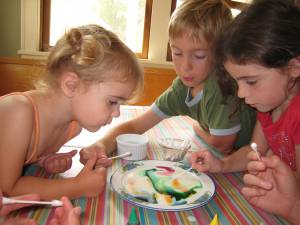
Food coloring isn’t just for frosting anymore! You will be amazed as you watch the forces of surface tension at work in this “brilliant” experiment.
All you’ll need is a small, shallow dish or plate, milk (2% or whole milk work best, but skim milk works too,) dishwashing liquid, Q-tips and food coloring.
I would recommend putting down newspaper and wearing an old shirt, since food coloring stains. You can make a lab coat from an old button-down shirt, by writing your name on the pocket with permanent marker.
First, add enough milk to cover the bottom of the dish. In a separate small container, mix together about a half cup of water with a squirt of dish-soap (a teaspoon or so.) Put several drops of different colored food coloring into the milk (maybe two drops of each color.)
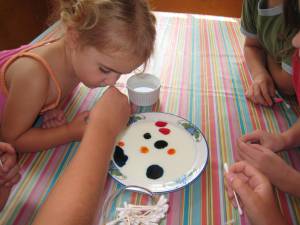
Dip a Q-tip into the dish-soap mixture and then touch the Q-tip to the milk. You don’t need to stir ! The detergent will break the surface tension of the milk and the food coloring will swirl around in interesting patterns, as if by magic.

Play with it! You can keep re-wetting your Q-tip with soapy water and touching it to the milk. If you want to, compare how the experiment works with skim milk versus whole milk. Sixth-graders will love it as much as two-year olds!
Now, draw a picture in your science notebook of how the milk looked before and after you touched it with the Q-tip! Take a picture of it and tape it your notebook! Describe what happened with words or pictures.
What Happened? Imagine that surface of liquids is a stretched elastic skin, like the surface of a balloon full of air. The scientific name for the way the “skin” of a liquid holds together is surface tension. When the skin of the liquid is broken, whatever is underneath will be able to escape, like the air rushing out of a balloon.
In this experiment, the surface of milk is like the elastic skin and dish detergent is what breaks the “skin” of the milk, sort of like a pin popping a balloon. Food coloring and more milk then escape from underneath the milk’s surface, swirling to the top.
Click here to watch my video on how to make tie-dye milk.
Tags: kids science , surface tension , tie-dye milk In: Chemistry Experiments , Physics Experiments | 10 comments »
Leave a comment
Name (required)
Mail (will not be published) (required)
XHTML: You can use these tags: <a href="" title=""> <abbr title=""> <acronym title=""> <b> <blockquote cite=""> <cite> <code> <del datetime=""> <em> <i> <q cite=""> <s> <strike> <strong>

IMAGES
COMMENTS
Feb 24, 2014 · A couple weeks ago, my six year old daughter, Olivia, had to perform a science experiment for her grade one class. After hours of researching online, Olivia chose to do this colorful milk swirl experiment. We added our own twist to the experiment, keeping the fun going by blowing gently on the milk to “tie dye” the milk.
The Science of Tie-Dye Milk. Milk is a mixture. It’s mostly water, but it also has proteins, fats, and other molecules mixed in. Because milk is mostly made up of water, it acts a lot like water and has many of the same properties. One of these properties is called surface tension.
How to Make Tie-Dye Milk Step 1: Add just enough milk to cover the bottom of the dish, since a thin layer works best. Step 2: In a separate small container, have your child mix about half a cup of water with a big squirt of dish soap (a teaspoon or so).
a fun and easy science experiment for kids of all ages using ingredients found in your home!PLEASE LIKE, COMMENT, & SUBSCRIBE :)Free background music from J...
Oct 15, 2024 · Touch the milk with the cotton swab and hold it still. Watch the milk “run away” from the soap. I love watching the tie-dye magic happen every time! What’s really fun about this experiment is that the color swirls are different each time you do it! My youngest (age 22 months) enjoyed swirling the colors around herself with the cotton swab.
Jul 26, 2017 · Step 3: Dip the Q-tip into the dish soap and place in the milk. Watch the food coloring move without being stirred creating a tie dye look! We had a lot of fun using different patterns of food coloring drops to create different effects when the dish soap was added.
Pour a layer of milk in the dish about 1/2" (1 cm) deep. Room temperature milk works much better than cold milk, if you have the patience to let it sit for a while. Carefully put one small drop of each of the four food colors onto the surface of the milk, widely separated, and not in the center of the dish (less is better than more!). Something ...
Feb 12, 2017 · My kids love doing simple science experiments and this Tie-dye milk experiment is so simple to set up and will keep kids entertained and learning. Video of Tie-Dye Milk Experiment Check out the below video to see the boys doing this experiment and then read on to learn how to do it yourself:
Apr 16, 2020 · Take the soapy cotton swab (or toothpick) and touch the center of the milk with it. Watch what happens to the milk and food coloring. Wait for 30 seconds, then try adding a second drop of dish soap. Option: Try the experiment again with a different variety or fat content of milk. How does it differ? How does the fat content impact the results?
In this experiment, the surface of milk is like the elastic skin and dish detergent is what breaks the “skin” of the milk, sort of like a pin popping a balloon. Food coloring and more milk then escape from underneath the milk’s surface, swirling to the top. Click here to watch my video on how to make tie-dye milk.